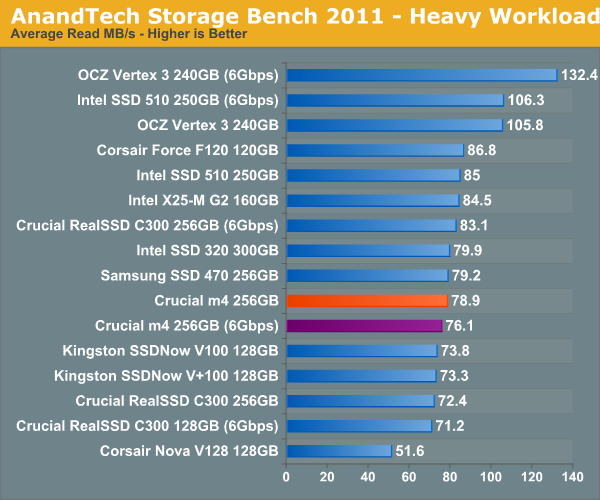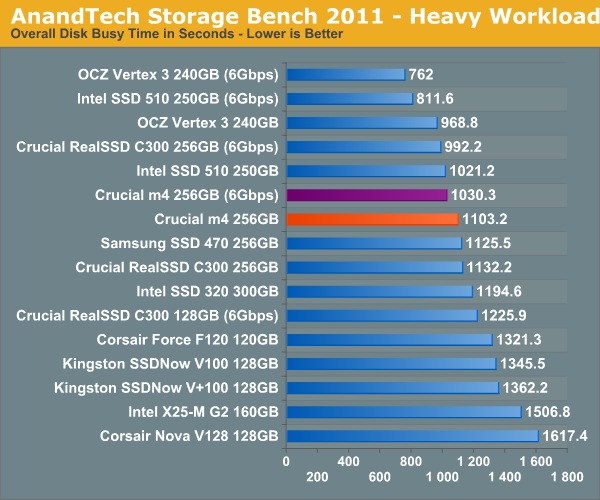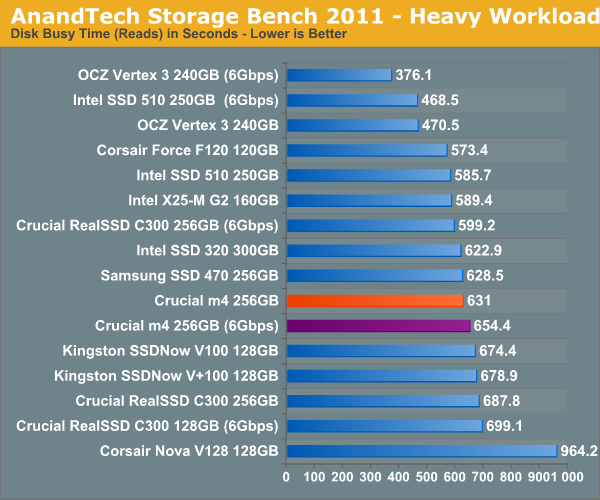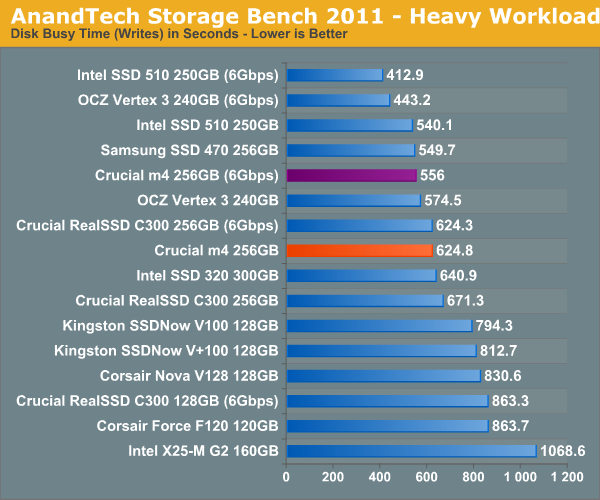The Crucial m4 (Micron C400) SSD Review
by Anand Lal Shimpi on March 31, 2011 3:16 AM ESTAnandTech Storage Bench 2011: Much Heavier
I didn't expect to have to debut this so soon, but I've been working on updated benchmarks for 2011. Last year we introduced our AnandTech Storage Bench, a suite of benchmarks that took traces of real OS/application usage and played them back in a repeatable manner. I assembled the traces myself out of frustration with the majority of what we have today in terms of SSD benchmarks.
Although the AnandTech Storage Bench tests did a good job of characterizing SSD performance, they weren't stressful enough. All of the tests performed less than 10GB of reads/writes and typically involved only 4GB of writes specifically. That's not even enough exceed the spare area on most SSDs. Most canned SSD benchmarks don't even come close to writing a single gigabyte of data, but that doesn't mean that simply writing 4GB is acceptable.
Originally I kept the benchmarks short enough that they wouldn't be a burden to run (~30 minutes) but long enough that they were representative of what a power user might do with their system.
Not too long ago I tweeted that I had created what I referred to as the Mother of All SSD Benchmarks (MOASB). Rather than only writing 4GB of data to the drive, this benchmark writes 106.32GB. It's the load you'd put on a drive after nearly two weeks of constant usage. And it takes a *long* time to run.
I'll be sharing the full details of the benchmark in some upcoming SSD articles but here are some details:
1) The MOASB, officially called AnandTech Storage Bench 2011—Heavy Workload, mainly focuses on the times when your I/O activity is the highest. There is a lot of downloading and application installing that happens during the course of this test. My thinking was that it's during application installs, file copies, downloading and multitasking with all of this that you can really notice performance differences between drives.
2) I tried to cover as many bases as possible with the software I incorporated into this test. There's a lot of photo editing in Photoshop, HTML editing in Dreamweaver, web browsing, game playing/level loading (Starcraft II & WoW are both a part of the test) as well as general use stuff (application installing, virus scanning). I included a large amount of email downloading, document creation and editing as well. To top it all off I even use Visual Studio 2008 to build Chromium during the test.
Update: As promised, some more details about our Heavy Workload for 2011.
The test has 2,168,893 read operations and 1,783,447 write operations. The IO breakdown is as follows:
| AnandTech Storage Bench 2011—Heavy Workload IO Breakdown | ||||
| IO Size | % of Total | |||
| 4KB | 28% | |||
| 16KB | 10% | |||
| 32KB | 10% | |||
| 64KB | 4% | |||
Only 42% of all operations are sequential, the rest range from pseudo to fully random (with most falling in the pseudo-random category). Average queue depth is 4.625 IOs, with 59% of operations taking place in an IO queue of 1.
Many of you have asked for a better way to really characterize performance. Simply looking at IOPS doesn't really say much. As a result I'm going to be presenting Storage Bench 2011 data in a slightly different way. We'll have performance represented as Average MB/s, with higher numbers being better. At the same time I'll be reporting how long the SSD was busy while running this test. These disk busy graphs will show you exactly how much time was shaved off by using a faster drive vs. a slower one during the course of this test. Finally, I will also break out performance into reads, writes and combined. The reason I do this is to help balance out the fact that this test is unusually write intensive, which can often hide the benefits of a drive with good read performance.
There's also a new light workload for 2011. This is a far more reasonable, typical every day use case benchmark. Lots of web browsing, photo editing (but with a greater focus on photo consumption), video playback as well as some application installs and gaming. This test isn't nearly as write intensive as the MOASB but it's still multiple times more write intensive than what we were running last year.
As always I don't believe that these two benchmarks alone are enough to characterize the performance of a drive, but hopefully along with the rest of our tests they will help provide a better idea.
The testbed for Storage Bench 2011 has changed as well. We're now using a Sandy Bridge platform with full 6Gbps support for these tests. All of the older tests are still run on our X58 platform.
AnandTech Storage Bench 2011—Heavy Workload
We'll start out by looking at average data rate throughout our new heavy workload test:

While we saw a pretty significant difference between 3Gbps and 6Gbps interfaces with the Intel 510 and Vertex 3, but the same can't be said about Crucial's m4. There's only a 7% performance improvement seen by using a 6Gbps connector on our Sandy Bridge system. Even more interesting is that performance actually drops a bit compared to the C300. We saw this in some of our synthetic Iometer tests and it's definitely reflected here.
The breakdown of reads vs. writes tells us more of what's going on:

The drop in sequential and random read performance we noticed seems to be at fault for the m4's lower-than-C300 performance. Looking at write speeds we actually see an improvement over the C300:

The next three charts just represent the same data, but in a different manner. Instead of looking at average data rate, we're looking at how long the disk was busy for during this entire test. Note that disk busy time excludes any and all idles, this is just how long the SSD was busy doing something:













103 Comments
View All Comments
Drag0nFire - Thursday, March 31, 2011 - link
Dear Anand,Thank you so much for your comments on NAND longevity. Very much appreciated to go through the math one more time in the context of these drives.
One remaining question: is your assumption of 7GB per day really appropriate. If I have a laptop with 4GB of RAM (not rare today) and I hibernate my laptop (or use hybrid sleep) an average of twice a day, I've already exceeded your usage scenario.
I understand that I should still not be concerned about the longevity of the drives... but perhaps a more conservative estimate for the math would be appropriate.
Thanks,
--Jonathan
sor - Thursday, March 31, 2011 - link
If you are hibernating your laptop twice a day, you're doing it wrong. That's what suspend to RAM is for, your laptop should last up to a few days in that state. Only hibernate when battery is low (or just shut down).I was thinking 7GB/day average is actually fairly high, considering that playing games, web browsing, and document editing are all fairly light on writes.
Chloiber - Friday, April 1, 2011 - link
How much RAM are you using? You laptop only writes RAM on your disk which is actually used.However, I also think 7GB/day isn't that much. On my desktop I'm at over 10GB/d (Postville, using since July '09).
Still, I don't think that NAND lifetime is an issue. You should worry more about firmware bugs. That's the thing that kills your data more than anything else at the moment.
wrickard - Thursday, March 31, 2011 - link
I think the test results should include the firmware revisions.Seems these can affect performance significantly.
Could you add a note with the firmware revisions in the reviews?
Bozzunter - Thursday, March 31, 2011 - link
Anand: TRIM appears to be finally available, for any drive, on Mac Os, do you plan to run some tests there, too? Check http://www.groths.org/?p=308.MilwaukeeMike - Thursday, March 31, 2011 - link
Have you ever considered creating a benchmark based on type of user? Make up some names and show them which drive would be the best for them. Frank the multitasker has to open 75 word docs a day, view power points, excel sheets, move documents around and convert docs to .PDF. Here's how the drives perform for this type of user. Sue the gamer hates waiting for screens to load while travelling between zones in her favorite MMO, here's how the drives perform for her. Bob the buildier is a software developer and blogger. He has to move large video files around, and uses larger programs like visual studio and photoshop... etc... you get the idea. Call me ingorant, but i have no idea how 4KB write speed with no queue depth translates into real-world use, let alone noticeable real-world use.I'm not ripping the review, i think it's very comprehensive, we just need some better translating for us lay people.
thesegreydays - Thursday, March 31, 2011 - link
Anand, thanks for another great review!However, I'm anticipating Corsairs new offerings and I haven't really heard any news about the Force GT since CeBIT.
Are you going to release a review of it in the near future and is Corsair still aiming for a "early 2nd quarter" release?
Modus - Thursday, March 31, 2011 - link
Some SSD's reduce the number of NAND channels for their smaller capacity models of the same line, reducing performance on certain workloads. I'm always disappointed when reviewers don't go back and test the smaller capacity versions. Since most users still benefit most from a small SSD as an OS/apps/game drive to complement a larger mass-storage HD, these same users will often end up with smaller 40~60~80 GB SSD's, and it's often hard to find performance reviews of these drives from top-tier sites like AnandTech.Anand, we love the job you do. I just want to remind you to not forget about the smaller drive capacities. And I do see that your Bench database contains some of those. But like most reviewers, you seem to be naturally focused on the high-end capacities.
KineticHummus - Thursday, March 31, 2011 - link
Anandtech normally focuses on the high-end because that is what is sent to them to review. They do not normally go out and purchase these drives, the manufacturers send them in, so it is the manufacturer's choice which drives are reviewed and which arent.vedye - Thursday, March 31, 2011 - link
Just started reading about SSDs and noticed how the TRIM command can affect the performance.A quick question, is format the only way to trigger TRIM? i.e. to use C4 for Windows 7 (that supports Trim) as OS disk, does it mean i need to format and reinstall the OS every now and then?
Cheers